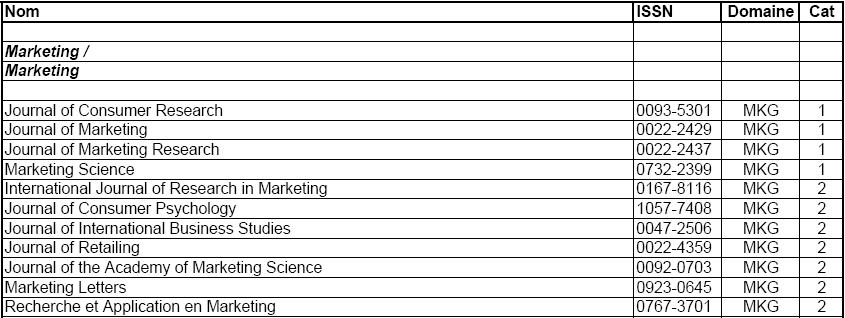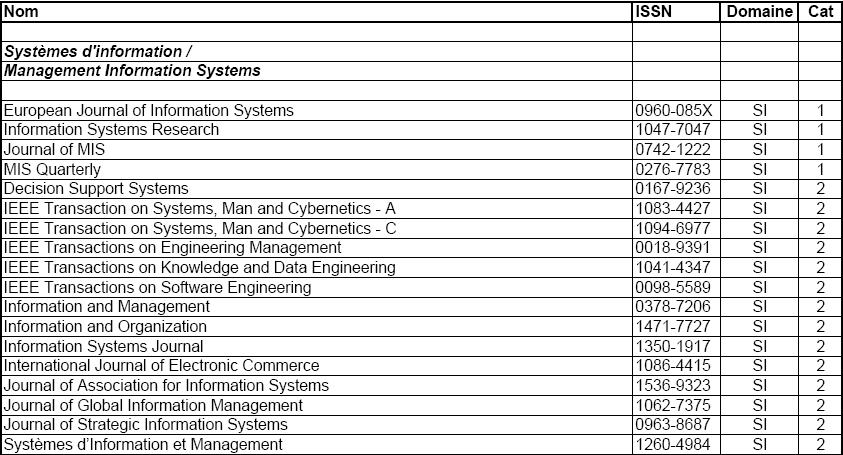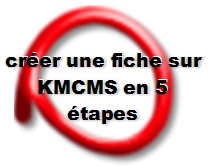Author(s) : Jean-Eric PELET
Agenda
- Content of the synthesis
- Format of the synthesis
- Sources of interest
- Other interesting sources
- Journal’s categorization
- Marketing
- Information System
- Student information
The 2-3 pages maximum synthesis will be uploaded on kmcms.net Abstract:
- (Times 12, italics, justified left and right): copy paste the abstract of the article you have read if it already exists
- Authors must supply a structured abstract set out under the following sub-headings (maximum is 250 words in total):
- Purpose (mandatory)
- Design/methodology/approach (mandatory)
- Findings (mandatory)
- Practical implications (if applicable)
Keywords: Cicero, Catiline, Orations , Distribueudos (3-5) copy paste the key words of the article you have read if it already exists
Content of the synthesis
- Topic
- Reference
- Literature review
- Hypothesis
- Conceptual Model
- Experiment
- Scales
- Independent Variable
- Dependent Variable
- Results
- Conclusion
- Limits
- Future ways of research
- Critic
Format of the synthesis
- Body of the text: leave it as it is on kmcms.net
- Read it carefully please 🙂 (clic below)
- Best thing to do:
- write your synthesis in word, delete the mistakes – language of the article, either french or english -, make a very good work
- copy it from word in a notepad/blocnote file to delete the style (css) from word
- paste it from this notepad to kmcms.NET by creating a new post (and follow the advices provided in the syllabus – or below -)
- use Header 3 for titles Header 4 for sub titles (very important, to make your work readable)
- send me the url of your work (even those who already told me that have done their synthesis, I need this link, to watch your beautiful work to mark it at its best
-
- That’s it !
1. Headings
Use the < H3> < /H3> tags (Header 3)
1.1. Sub-heading
Use the < H4> < /H4> tags (Header 4)
Tables and figures should have a title, and should be annonced in the body of the text. They should be located at the right place in the paper. Table should not be submitted as graphic elements.
References to other publications must be in RAM (http://www.afm-marketing.org/afmnetfichiers/Instrcutions_aux_auteurs_RAM.pdf) style and carefully checked for completeness, accuracy and consistency. You should cite publications in the text: (Adams, 2006) using the first author’s name or (Adams and Brown, 2006) citing both names of two, or (Adams et al., 2006), when there are three or more authors. At the end of the paper a reference list in alphabetical order should be supplied:
- For books: Surname, Initials (year), Title of Book, Publisher, Place of publication. e.g. Harrow, R. (2005), No Place to Hide, Simon & Schuster, New York, NY.
- For book chapters: Surname, Initials (year), "Chapter title", Editor’s Surname, Initials (Ed.), Title of Book, Publisher, Place of publication, pages. e.g. Calabrese, F.A. (2005), "The early pathways: theory to practice – a continuum", in Stankosky, M. (Ed.), Creating the Discipline of Knowledge Management, Elsevier, New York, NY, pp. 15-20.
- For journals: Surname, Initials (year), "Title of article", Journal Name, volume, number, pages. e.g. Capizzi, M.T. and Ferguson, R. (2005), "Loyalty trends for the twenty-first century", Journal of Consumer Marketing, Vol. 22 No. 2, pp. 72-80.
- For published conference proceedings: Surname, Initials (year of publication), "Title of paper", in Surname, Initials (Ed.), Title of published proceeding which may include place and date(s) held, Publisher, Place of publication, Page numbers. eg Jakkilinki, R., Georgievski, M. and Sharda, N. (2007), "Connecting destinations with an ontology-based e-tourism planner", in Information and communication technologies in tourism 2007 proceedings of the international conference in Ljubljana, Slovenia, 2007, Springer-Verlag, Vienna, pp. 12-32.
- For unpublished conference proceedings: Surname, Initials (year), "Title of paper", paper presented at Name of Conference, date of conference, place of conference, available at: URL if freely available on the internet (accessed date). eg Aumueller, D. (2005), "Semantic authoring and retrieval within a wiki", paper presented at the European Semantic Web Conference (ESWC), 29 May-1 June, Heraklion, Crete, available at: http://dbs.uni-leipzig.de/file/aumueller05wiksar.pdf (accessed 20 February 2007).
- For working papers: Surname, Initials (year), "Title of article", working paper [number if available], Institution or organization, Place of organization, date. e.g. Moizer, P. (2003), "How published academic research can inform policy decisions: the case of mandatory rotation of audit appointments", working paper, Leeds University Business School, University of Leeds, Leeds, 28 March.
- For newspaper articles (authored): Surname, Initials (year), "Article title", Newspaper, date, pages. e.g. Smith, A. (2008), "Money for old rope", Daily News, 21 January, pp. 1, 3-4.
- For newspaper articles (non-authored): Newspaper (year), "Article title", date, pages. e.g. Daily News (2008), "Small change", 2 February, p. 7.
- For electronic sources: if available online the full URL should be supplied at the end of the reference, as well as a date that the resource was accessed. e.g. Castle, B. (2005), "Introduction to web services for remote portlets", available at: http://www-128.ibm.com/developerworks/library/ws-wsrp/ (accessed 12 November 2007).
Sources of interest
- Marketing: EBSCO / EMERALD INSIGHT / SCIENCE DIRECT / JSTOR etc.
- Information Systems: SCOPUS
Other interesting sources
- http://scholar.google.com
- Do not neglect Harvard’s or MIT articles even if they aren’t listed in the PDF table
Journal’s categorization
Marketing
More details : See this page for the whole categorization of journals in management

Information System
More details on Information Reviews: http://lamp.infosys.deakin.edu.au/journals/index.php


